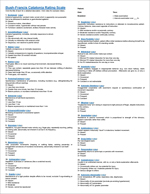Bush-Francis Catatonia Rating Scale
Dr. Wortzel and Dr. Oldham have developed the following educational resources on how to assess for catatonia using the Bush-Francis Catatonia Rating Scale (BFCRS) in collaboration with Dr. Francis.
Select the items below to view videos on BFCRS scoring. These can also be accessed from the PDF version of the BFCRS.
Extreme hyperactivity, constant motor unrest which is apparently non-purposeful. Not to be attributed to akathisia or goal-directed agitation.
0 = Absent
1 = Excessive motion, intermittent
2 = Constant motion, hyperkinetic without rest periods
3 = Full-blown catatonic excitement, endless frenzied motor activity
Extreme hypoactivity, immobile, minimally responsive to stimuli.
1 = Sits abnormally still, may interact briefly
2 = Virtually no interaction with external world
3 = Stuporous, non-reactive to painful stimuli
Verbally unresponsive or minimally responsive.
0 = Absent
1 = Verbally unresponsive to majority of questions; incomprehensible whisper
2 = Speaks less than 20 words/5 minutes
3 = No speech
Fixed gaze, little or no visual scanning of environment, decreased blinking.
0 = Absent
1 = Poor eye contact, repeatedly gazes less than 20 sec between shifting of attention; decreased blinking
2 = Gaze held longer than 20 sec, occasionally shifts attention
3 = Fixed gaze, non-reactive
Spontaneous maintenance of posture(s), including mundane (e.g., sitting/standing for long periods without reacting).
0 = Absent
1 = Less than one minute
2 = Greater than one minute, less than 15 minutes
3 = Bizarre posture, or mundane maintained more than 15 min
Maintenance of odd facial expressions.
0 = Absent
1 = Less than 10 sec
2 = Less than 1 min
3 = Bizarre expression(s) or maintained more than 1 min
Mimicking of examiner's movements/ speech.
0 = Absent
1 = Occasional
2 = Frequent
3 = Constant
Repetitive, non-goal-directed motor activity (e.g. finger-play; repeatedly touching, patting or rubbing self); abnormality not inherent in act but in its frequency.
0 = Absent
1 = Occasional
2 = Frequent
3 = Constant
Odd, purposeful movements (hopping or walking tiptoe, saluting passersby or exaggerated caricatures of mundane movements); abnormality inherent in act itself.
0 = Absent
1 = Occasional
2 = Frequent
3 = Constant
Repetition of phrases or sentences (like a scratched record).
0 = Absent
1 = Occasional
2 = Frequent, difficult to interrupt
3 = Constant
Maintenance of a rigid position despite efforts to be moved, exclude if cog-wheeling or tremor present.
0 = Absent
1 = Mild resistance
2 = Moderate
3 = Severe, cannot be repostured
Apparently motiveless resistance to instructions or attempts to move/examine patient. Contrary behavior, does exact opposite of instruction.
0 = Absent
1 = Mild resistance and/or occasionally contrary
2 = Moderate resistance and/or frequently contrary
3 = Severe resistance and/or continually contrary
During reposturing of patient, patient offers initial resistance before allowing himself to be repositioned, similar to that of a bending candle.
0 = Absent
3 = Present
Refusal to eat, drink and/or make eye contact.
0 = Absent
1 = Minimal PO intake/ interaction for less than one day
2 = Minimal PO intake/ interaction for more than one day
3 = No PO intake/interaction for one day or more
Patient suddenly engages in inappropriate behavior (e.g. runs down hallway, starts screaming or takes off clothes) without provocation. Afterwards can give no, or only a facile explanation.
0 = Absent
1 = Occasional
2 = Frequent
3 = Constant or not redirectable
Exaggerated cooperation with examiner's request or spontaneous continuation of movement requested.
0= Absent
1= Occasional
2= Frequent
3= Constant
"Anglepoise lamp" arm raising in response to light pressure of finger, despite instructions to the contrary.
0 = Absent
3 = Present
Resistance to passive movement which is proportional to strength of the stimulus, appears automatic rather than willful.
0 = Absent
3 = Present
Patient appears motorically "stuck" in indecisive, hesitant movement.
0 = Absent
3 = Present
Per neurological exam.
0 = Absent
3 = Present
Repeatedly returns to same topic or persists with movement.
0 = Absent
3 = Present
Usually in an undirected manner, with no, or only a facile explanation afterwards.
0 = Absent
1 = Occasionally strikes out, low potential for injury
2 = Frequently strikes out, moderate potential for injury
3 = Serious danger to others
Circle: temperature, BP, pulse, respiratory rate, diaphoresis.
0 = Absent
1 = Abnormality of one parameter [exclude pre-existing hypertension]
2 = Abnormality of 2 parameters
3 = Abnormality of 3 or greater parameter
